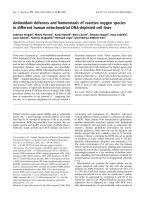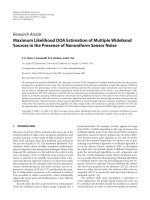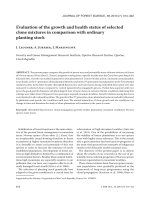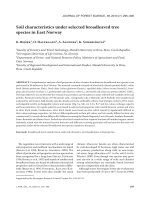Estimation of carbon sequestration of selected tree species in Intanki National Park, Nagaland, India
Bạn đang xem bản rút gọn của tài liệu. Xem và tải ngay bản đầy đủ của tài liệu tại đây (492.13 KB, 6 trang )
Int.J.Curr.Microbiol.App.Sci (2018) 7(9): 1488-1493
International Journal of Current Microbiology and Applied Sciences
ISSN: 2319-7706 Volume 7 Number 09 (2018)
Journal homepage:
Original Research Article
/>
Estimation of Carbon Sequestration of Selected Tree Species
in Intanki National Park, Nagaland, India
Anguno Tase*, Amit Larkin and Hemant Kumar
College of Forestry, Sam Higginbottom University of Agriculture Technology & Sciences,
Allahabad-U.P-211007, India
*Corresponding author
ABSTRACT
Keywords
Above ground biomass,
Below ground biomass,
Carbon sequestration,
Moisture content, Fixed
carbon, Climate change
Article Info
Accepted:
10 August 2018
Available Online:
10 September 2018
The study was carried out to investigate the above ground biomass, below ground biomass
and estimate the total carbon sequestration of the selected tree species found in Intanki
National Park, Nagaland viz., Tetrameles nudiflora, Cyclostemum assamicus, Mansonia
dipikae, Dillenia indica, Bischofia javanica, Polyathia cerasoides and Amoora wallichii
by non-destructive method. The estimation of the biomass was performed by measuring
the tree height and diameter with the help of Ravi altimeter and measuring tape
respectively. Total above ground biomass was recorded highest for the Bischofia javanica
(7.570 tons tree-1) while the maximum below ground biomass (1.133 ton tree -1) was
observed for Mansonia dipikae. The maximum wood moisture content (61%) was
recorded for Tetrameles nudiflora. Maximum fixed carbon (62.7%) was recorded in
Cyclostemum assamicus while the minimum (38.4%) was recorded for Tetrameles
nudiflora. It was also observed that the amount of carbon sequestration was highest (2.977
t C tree-1) in Bischofia javanica and the minimum (0.066 t C tree-1) was recorded for
Mansonia dipikae. The trees which were examined are important multipurpose tree species
grown in Intanki National Park and are significant components of Agro forestry and
plantation forestry in the study region.
Introduction
The threat of climate change is now
overwhelming the dialogue on forest policy.
Forests, like other ecosystems, will be affected
by temperature increase. But the dimension
that is receiving much more attention is their
role as a store for carbon. Forests hold more
carbon than the atmosphere, and the
interchange of carbon between the two is a
major element in the climate change, and
reducing this is seen as a low-cost way of
mitigating the threat of climate change.
Tropical forests play an important role in the
global carbon cycle based both in terms of
regulating the carbon flux between the
biosphere and the atmosphere, and in terms of
the amount of carbon stored. Tropical forests
harbouring rich biodiversity are responding in
several ways to global climate change leading
to shifts in species composition and overall
increase in turnover (Phillips and Gentry,
1994). Tropical forests clearly dominate the
role of forests in the global carbon cycle based
both on C flux, and the volume of carbon
stored. Deforestation and forest degradation in
1488
Int.J.Curr.Microbiol.App.Sci (2018) 7(9): 1488-1493
the tropics currently account for about 20% of
the GHG emissions and constitute the majority
of emissions from developing countries
(IPCC, 2007; Gullison et al., 2007). Reduced
Emissions recognizing the importance of
tropical forests and the value of developing
countries participation in the global REDD is
an instrument to maintain carbon pools,
support
sustainable
development
and
mechanism to reward countries with carbon
credits for preserving their forest cover.
Species play a potentially important role
enhancing ecosystem capacity to recover and
adapt to the impacts of climate change.
Substantial amounts of carbon can be
sequestered through forestry, compared to the
net volume of carbon released into the
atmosphere. Tropical forests are one of the
riches and complex terrestrial ecosystems
supporting a variety of life forms and have a
tremendous ability for self-sustain. Due to
increasing biotic, anthropogenic interference,
grazing and other illegal activities these
forests are losing their ability (Swamy et al.,
2010).
It is a well-known fact now that forests are
important component of global carbon (C)
cycle. Forests are part of a wider ecosystem
and deliver services that are far more than
forest even from the perspective of climate
change. (Dixon et al., (1994) estimated that
approximately 1146 pentagrams of carbon are
stored in the world’s forested ecosystems.
Forest account for more than 75% of the
carbon stored in terrestrial ecosystems and
approximately 40% of the carbon exchange
between the atmosphere and the terrestrial
biosphere each year (Schlesinger, 1997).
Indian forests are known to be one of the
richest in terms of vegetation types and
species diversity. Forest plays a major role in
the global carbonic cycle by capturing carbon
(C)
from
the
atmosphere
through
photosynthesis, converting it to forest biomass
and releasing it into the atmosphere through
plant respiration and decomposition. Plants
and especially forests are of particular
importance as they are major regulators of
global climate and are keystone of the carbon
cycle. Forest already serves as a substantial
warehouse for carbon. Forest growth naturally
stores, or “sequesters” carbon, and the carbon
remains in the wood after it is processed into a
product. Climate change escalates the already
existing vulnerabilities of Nagaland and could
manifest disastrously if not addressed
adequately. Chaturvedi (1994) estimated that
in Indian forests, one tonne of carbon could be
sequestered by 2.2 tonnes of wood. Studies
have established that carbon sequestration by
trees could provide relatively net emission
reductions (Callaway and McCarl, 1996,
Stavins, 1999).
Materials and Methods
The experiment was conducted in Intanki
National Park, Nagaland. Intanki is located in
Peren District of Nagaland and spreads over
an area of 202km2. It’s altitude varies from
200m to 682m (msl) at 93˚ 15’ to 25˚ 18’ to
25˚43’ N latitude and 93˚ 43’ longitude. The
temperature generally ranges from less than 0
degree Celsius to 35 degree C. In summer,
maximum and minimum temperature is 31
degree C to 16 degree C respectively. Forest
of this National park is of Tropical moist
deciduous and Tropical semi-evergreen type.
Three trees of each species were selected and
three samples of 10x3x2 cm were collected
from each tree. The species selected
Tetrameles
nudiflora,
Cyclostemum
assamicus, Mansonia dipikae, Dillenia indica,
Bischofia javanica, Polyathia cerasoides,
Amoorawalichii.
Biophysical measurements
The height and diameter at breast height
(DBH) are the two main biophysical
measurements which were measured for each
1489
Int.J.Curr.Microbiol.App.Sci (2018) 7(9): 1488-1493
tree sample. The tree height was determined
with the help of RAVI ALTIMETER in
meters. Diameter at breast height was
measured in meters using measuring tape.
Above-ground biomass includes all living
biomass above the soil. The above-ground
biomass (AGB) has been calculated by
multiplying volume with specific gravity.
The volume was calculated based on diameter
and height.
Specific gravity was calculated by the ratio of
oven dry weight and green volume of the
pieces of wood samples.
Aboveground biomass (t C tree-1) = Volume
of tree (m3) x specific gravity (g cm3)
The Below Ground Biomass (BGB) includes
all biomass. The belowground biomass (BGB)
accounts for about 15% of the total tree
biomass.
Belowground biomass (t tree-1) = AGB X
(15/100)
Total carbon sequestration was estimated as
the product of total above ground biomass and
fixed carbon.
Total carbon sequestration (t C tree-1) = Total
Biomass x Fixed carbon (%). (Jana et al.,
2009).
Results and Discussion
Biomass estimation
The biomass of the selected tree species is
shown in Table 1 and Figure 1. The maximum
above ground biomass 7.570 tC tree-1 was
found for Bischofia javanica, the minimum
1.856 tC tree-1 was found for Polyathia
cerasoides. The maximum below ground
biomass 1.133 tC tree-1 was found for
Mansonia dipikaefollowed by Bischofia
javanica 0.954 tC tree-1, the minimum was
found for Polyathia cerasoides 0.278 tC tree-1.
And the maximum total biomass was found
for Mansonia dipikae with 8.687 tC tree-1 with
the
minimum
observed
in
Polyathiacerasoides2.134 tC tree-1.
Fixed carbon estimation
Fixed carbon mainly contributes to carbon
storage.
It was calculated as:
Fixed carbon (%) = 100 – Ash content –
Moisture content (Ganeshaiah et al., 2003).
From figure 2 it has been observed that the
highest fixed carbon was recorded 62.7% was
recorded for Cyclostemum assamicus which
was statistically at par with Amoorawalichi
59.3%. The minimum fixed carbon 38% was
obtained for Tetrameles nudiflora.
Table.1 Aboveground biomass (AGB), belowground biomass (BGB) and Total biomass (TB) of
the selected tree species
S.N
1
2
3
4
5
6
7
Species
Tetrameles nudiflora
Cyclostemum assamicus
Mansonia dipikae
Dillenia indica
Bischofia javanica
Polythia cerasoides
Amoora wallichii
AGB (t tree-1)
6.509
2.010
7.554
2.735
7.570
1.856
1.933
1490
BGB (t tree-1)
0.929
0.307
1.133
0.374
0.954
0.278
0.302
TB (t tree-1)
7.438
2.317
8.687
3.109
8.524
2.134
2.235
Int.J.Curr.Microbiol.App.Sci (2018) 7(9): 1488-1493
Fig.1 Location of the study area (Intanki National Park, Nagaland)
Fig.2 Total biomass variation in the different tree species
Total Biomass (t tree-1)
1491
Int.J.Curr.Microbiol.App.Sci (2018) 7(9): 1488-1493
Fig.3 Fixed carbon of the different tree species selected
70
Fixed Carbon %
60
50
40
30
20
10
0
Tetrameles Cyclostemum
nudiflora
assamicus
Mansonia Dillenia indica
dipikae
Bischofia
javanica
Polyathia
cerasoides
Amoora
walichii
Fig.4 Carbon sequestration (tC tree-1) of the selected tree species
3.5
3
2.5
2
1.5
1
0.5
0
Carbon Sequestration (t C/tree-1)
The estimation of the total carbon sequestered
by the selected tree species are shown in Figure
3. It was recorded that the maximum total
carbon sequestration 2.9774 tC tree-1 was found
for Bischofia javanica followed by Tetrameles
nudiflora 2.5442 tC tree-1. The minimum carbon
sequestration was for Mansonia with 0.6688 tC
tree-1.
Findings of above study concludes that the
maximum total biomass was found for
Bischofia javanica with 7.570 tons sequestering
2.9774 tons of carbon followed by Tetrameles
nudiflora 6.509 tons sequestering 2.5442 tons of
carbon. The species Mansonia dipikae had the
lowest carbon sequestration potential i.e. 0.6688
tons. Cyclostemum assamicus had the maximum
fixed carbon of 62.7% followed by
Amoorawalichii 59.3%. Tetrameles nudiflora
had the minimum fixed carbon of 38.4%. The
research can be useful for estimating carbon
sequestration potential of the tree species found
in Intanki National park, Nagaland for assessing
the contribution in carbon sequestration by the
1492
Int.J.Curr.Microbiol.App.Sci (2018) 7(9): 1488-1493
tree species as well conservation aspects of
above mentioned species for higher carbon
stock.
References
Chhabra, A. and Dadhwal V. K. (2004)
Assessment of major pool of fluxes of
carbon in Indian forests.
Hu H., Y. Liu, and J. Yan (2007). Estimation of
the carbon storage of forest vegetation
and carbon emission from forest fires in
Heilongjiang Province, China. Journal of
Forestry Research.
Jana, B. K., S. Biswas, M. Majumder, P. Roy
and A. Mazumdar (2009). Carbon
sequestration rate and above ground
biomass carbon potential of four young
species.
Ecology
and
Natural
Environment.
Joshi Meenakshi, Preet Pal Singh (2003)
Carbon sequestration by rehabilitating
degraded forests in India.
Jussi Laurila (2013). Moisture content, weight
loss and potential of energy wood in
South and central Ostrobothnia regions in
Western
Finland.
Dissertations
Forestales.
Mani, S., N Parthasarathy (2007). Above
ground biomass estimation in ten tropical
dry evergreen forest sites of peninsular
India. Biomass and Bioenergy.
Murali, K. S., D.M. Bhat, N. H. Ravindranath
(2005). Biomass estimation equation for
tropical deciduous and evergreen forests.
International Journal of Agricultural
Resources, Governance and Ecology.
Nishith Dharaiya and Jagruti Jagiwala (2013)
Estimating carbon sequestration in forest
vegetation through several scientific
methods: a review to find competent
method for Indian forest national monthly
referred journal of research in science &
technology.
Onkar Salunkhe, P. K. Khare, T. R. Sahu and
Sarnam Singh (2016) Estimation of tree
biomass reserves in tropical deciduous
forests of Central India by nondestructive approach. Tropical Ecology.
Pandya, Ishan Y. (2012) Estimation of carbon
storage in heritage tree species of
purnawil
Ravindranath N. H., Somashekhar R.S. and
Cadgil M. 1997. Carbon flows in Indian
forests. Dlife sanctuary of Dangs district
of vibrant Gujarat. Indian Journal science.
Sah, J.P., et al., (2004). Estimating
aboveground biomass of broadleaved
woody plants in the understory of Florida
Keys pine forests. Forest Ecology and
Management.
Santantonio D, Hermann R K, Overton WS
(1977). Root biomass studies in forest
ecosystems.
Vashum, K. T. and S. Jayakumar. 2012.
Methods to estimate above ground
biomass and carbon stock in natural forest
- a review. Journal of Ecosystem and
Ecography.
Vendrapati Srinivasa Rao and Boyina Ravi
Prasad Rao 2015 Carbon sequestration
potential of tropical deciduous forests of
Nallamalais,
India.
Biodiversity
Conservation Division, Department of
Botany, Sri Krishnadevaraya University,
Anantapur, Andhra Pradesh, India.
Zhou, X., and M. A. Hemstrom (2009)
Estimating Aboveground Tree Biomass
on Forest Land in the Pacific Northwest:
A Comparison of Approaches.
How to cite this article:
Anguno Tase, Amit Larkin and Hemant Kumar. 2018. Estimation of Carbon Sequestration of
Selected Tree Species in Intanki National Park, Nagaland, India. Int.J.Curr.Microbiol.App.Sci.
7(09): 1488-1493. doi: />
1493









